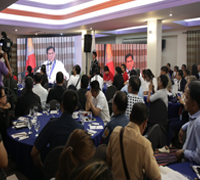21 water champions pinarangalansa World Water Day
Dahilsapatuloynapagtataguyod at pagpapanatilisamalinisnatubig at maayosnakapaligiran ay umabotsa 21 katao, institusyon at programaangpinarangalan at tinawagna “water champions” saginanapna World Water Day Awards 2019.
Ang awards ay ipinagkaloobsaginanapnaseremonyanoongMarso 22 (Biyernes) kasabay ng pagdiriwang ng World Water Day na may temangayongtaonna “Hawak-Kamay, TubigKaagapay”.
AyonkayExecutive Director Sevillo David, Jr. ng National Water Resources Board (NWRB), mas maramiangnabigyan ng award ngayongtaonkumparanoongnakalipasnataonna 18 lamang.
“More and more are becoming our partners for securing our water future. Working hand-in-hand is truly key to addressing challenges in water security,” sabi pa nito.
Ginanapang awarding ceremony sa Novotel Hotel Manila saAraneta Center saCubao, Quezon City. Ito ay inorganisa ng NWRB kasama ng water concessionaire naMaynilad.
Nagingpangunahingtagapagsalitasaokasyonsi Cabinet Secretary KarloNograles kung saan ay tiniyaknitonaprayoridad ng Duterte administration angusapinsatubig.
Ani pa niNograles,gumagawarin ng paraananggobyernoupangmaibsana
Nagmulasaiba’t-ibanginstitusyonangmgaipinamigayna award.
Kinilala ng River Basin Control Office ng Department of Environment and Natural Resources (DENR) ang Pampanga River Basin Committee bilang “Bagani ng Katubigan” dahilsaepektibonitongpamamahala.
Napilinaman ng DENR-National Capital Region bilang “Kampeon ng Katubigan” angMalabon City Environment and Natural Resources Office dahilsaiba’t-ibang greening programs nitokabilangnaangpagmementinas
Ang Environmental Management Bureau ng DENR ay ipinagkaloobsadalawangindibidwalang Water Leadership Award. Sila ay sina Franco RinoApoyon, coordinator ng Youth for Environment in Schools Organization ng Kabasalan National High School saZamboanga, Sibugay at Armay Jay Dudas, team leader ng Mimaropa Young Leaders nanakabasesa Mindoro.
Ipinagkaloobnaman ng NWRBang Water-Wise Choice Award sa St. Luke’s Medical Center sa Quezon City at Don Pepe Henson Enterprises, Inc. dahilsapagtupad ng mgaitosamgaregulasyon at tamangpaggamit ng tubig.
Ang Laguna Lake Development Authority ng DENR ay napiliangapatna “Kampeon ng Lawa” ngayongtaon. Ito ay angBiñan City Centralized Material Recovery, Waste Processing and Transfer Station ng Laguna; YES to Green Program ni Rizal Governor Rebecca Ynares; Sta. Rosa Sub-Watershed Management Council at ang Alberto Malvar ng Mount Purro Nature Reserve Park saAntipolo City.
Kinilalanamanbilang “Planet-Wise Organization” angCamarines Norte District Engineering Office ng Department of Public Works and Highways (DPWH)dahilsamga environmental projects nitosamgakomunidadnakanilangnasasakupan. Inisponsoranang award ng NWRB, DPWH at Maynilad.
Ang “KavontogDo’tAweg” ay ipinagkaloob ng AboitizInfracapitalsa Davao City Watershed Management Council. Angpangalan ng award naitoay nagmulasasalitangManobo naangibigsabihin ay “Hero of the Water”.
Ipinagkaloobnaman ng Mayniladang Water Warrior Awards ngayongtaonsa Philippine Science High School Main Campus sa Quezon City para saWater Education category,habangang Pasig River Rehabilitation Commission Executive Director Jose Antonio Goitia ay kinilala para sakategoryangAdvocacy Leadership.
Apatna water districts namanangnakatanggap ng “HuwarangLingkodTubig” awards nainisponsoran ng Local Water Utilities Administration. Ito ay angmga water districts ng Baguio City, Metro Naga, Silay City at Isabela City.
Ang Metropolitan Waterworks and Sewerage System ay nag-isponsor ng tatlong award ngayongtaon. Angmganakatanggapnito ay ang General Nakar Sustainable Integrated Area Development Project para saKaagapaysaTubigKanlungan ng Umiray; Ipo Watershed BantayGubat para saKaagapaysaTubigKanlungan ng Ipo at ang Save La Mesa Watershed Project para saKaagapaysaTubigKanlungan ng La Mesa award.
- Details
- Parent Category: News & Events
- Category: Press Releases



